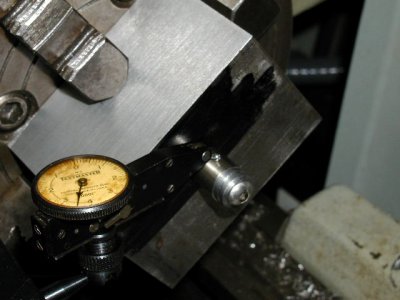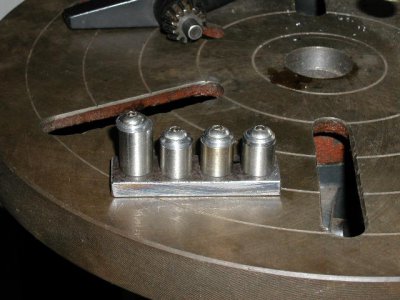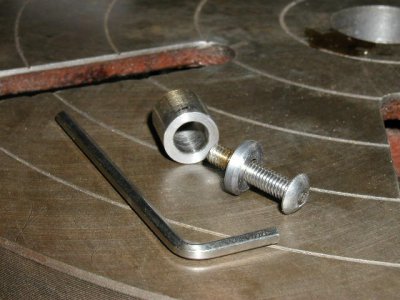-
Welcome back Guest! Did you know you can mentor other members here at H-M? If not, please check out our Relaunch of Hobby Machinist Mentoring Program!
You are using an out of date browser. It may not display this or other websites correctly.
You should upgrade or use an alternative browser.
You should upgrade or use an alternative browser.
Tooling Buttons
- Thread starter carl86
- Start date
- Joined
- Apr 30, 2011
- Messages
- 29
- Joined
- Jan 22, 2011
- Messages
- 8,031
Here's an old article with a couple of ways:
http://www.neme-s.org/Model_Engineer_Files/3147-Ways with Toolmakers Buttons.pdf
Another:
http://books.google.com/books?id=tt...;ved=0CI8BEOgBMAg#v=onepage&q&f=false
http://www.neme-s.org/Model_Engineer_Files/3147-Ways with Toolmakers Buttons.pdf
Another:
http://books.google.com/books?id=tt...;ved=0CI8BEOgBMAg#v=onepage&q&f=false
- Joined
- Jul 26, 2011
- Messages
- 4,142
Toolmaker's buttons were an OLD way to precision locate holes before more modern methods came about,such as jig boring machines that had high precision lead screws,and later on,DRO's.
Your holes had to be large enough,in the first place,to use them. You drilled and tapped a hole to mount the first button over. Then,by placing gage blocks between the 1st and 2nd. toolmaker's buttons,you could drill and tap as close to the 2nd.position as possible. Place the 2nd. button over the hole. Place gage blocks between the 2,and screw the 2nd button down tight. Same for all the buttons. Some were taller than others so you could reach them better with a dial indicator without getting fouled by the shorter buttons.
In essence,a way to establish exact distances between holes. The buttoned holes with their work piece of metal were then mounted on a lathe face plate. One at a time,they were brought in contact with an indicator,and very accurately centered up. Then,that centered button was taken off,and the hole could be single point bored out quite accurately. BUT,the boring had to be larger than the initial tapped and drilled hole.
By such methods,a MASTER PLATE could be made for doing something accurate,like boring all the holes for a clock's main plate. A perfectly centered stud on the face plate could be plugged into each hole that was bored in the master plate,and the hole in the clock plate could be bored. It was quicker than it sounds,but very slow compared to today's methods.
If you want to make REAL buttons,they must be VERY accurate to diameter,like .400",and precision ground on their outside surfaces. The ends must be perfectly square with the working surfaces of the button(also ground),but the interior hole can just be drilled,as nothing touches it,anyway. They are hardened to not get little grooves in them from the indicator tips(we are talking about very CLOSE tolerances,here.)
The best thing to do is buy them used. No one uses them these days,except guys like me. Most don't know what they really do,and generally they aren't real expensive,therefore.
Your holes had to be large enough,in the first place,to use them. You drilled and tapped a hole to mount the first button over. Then,by placing gage blocks between the 1st and 2nd. toolmaker's buttons,you could drill and tap as close to the 2nd.position as possible. Place the 2nd. button over the hole. Place gage blocks between the 2,and screw the 2nd button down tight. Same for all the buttons. Some were taller than others so you could reach them better with a dial indicator without getting fouled by the shorter buttons.
In essence,a way to establish exact distances between holes. The buttoned holes with their work piece of metal were then mounted on a lathe face plate. One at a time,they were brought in contact with an indicator,and very accurately centered up. Then,that centered button was taken off,and the hole could be single point bored out quite accurately. BUT,the boring had to be larger than the initial tapped and drilled hole.
By such methods,a MASTER PLATE could be made for doing something accurate,like boring all the holes for a clock's main plate. A perfectly centered stud on the face plate could be plugged into each hole that was bored in the master plate,and the hole in the clock plate could be bored. It was quicker than it sounds,but very slow compared to today's methods.
If you want to make REAL buttons,they must be VERY accurate to diameter,like .400",and precision ground on their outside surfaces. The ends must be perfectly square with the working surfaces of the button(also ground),but the interior hole can just be drilled,as nothing touches it,anyway. They are hardened to not get little grooves in them from the indicator tips(we are talking about very CLOSE tolerances,here.)
The best thing to do is buy them used. No one uses them these days,except guys like me. Most don't know what they really do,and generally they aren't real expensive,therefore.
- Joined
- Jul 26, 2011
- Messages
- 4,142
You must realize that,unless you are just playing around,these buttons actually MUST be made to gage block accuracy themselves. If not,placing gage blocks between them does absolutely no good at all.
- Joined
- Jul 26, 2011
- Messages
- 4,142
No,gage block accuracy is needed if you want true distances between hole locations to be established. Whatever the diameter of your buttons is,they must be very accurate to that diameter.You need to think it through. And,wringing the buttons is not necessary(or possible ) because they make a single line contact with the gage blocks,not a full surface contact area which has to be wrung to get full contact from.
) because they make a single line contact with the gage blocks,not a full surface contact area which has to be wrung to get full contact from.
Suppose your button is .399"in diameter instead of .400". You set up 2" of gage blocks between your buttons. Let's say the other button is a true .400" to be simple.
If your .399" button is .001" too small,the holes will end up being a half thousanth too close together. If you realize this,you can make allowance for it with an extra 1/2 thousanth of gage block. But,best to just make them accurate in the first place. You might forget if you don't use the for a while,and mess up a job with sloppy buttons.
A micrometer certainly can be used if your hole location is only accurate to a tenth. I tend to think of the ultimate use of tools. The book "Precision Hole Location" by the Moore jigbore makers,shows them used with gage blocks to make master plates for clock making. In earlier times,micrometers were used less than now,and gages were used more. Seems odd,but I guess good mics were more expensive then. Probably a .0001" mic was more rare back then,too. I have seen plenty of simple old gages for 1". Just cast iron,with the jaws accurately lapped. Seems cumbersome,but that's what they had.
Pressure? Hardened steel blocks and hardened steel buttons do not compress for all practical purposes. Neither does water for all practical purposes. If it did,we could not have accurate hydraulic operated machines.
A CERTAIN amount of skill is,of course,needed,in setting up anything very accurate. No one remotely skilled is going to hammer gage blocks into position. Or,cause enough force to cause the buttons to sink into the workpiece on 1 side and lean. The little screw holding it in place would slip long before that happened.
I have an indicator that is accurate to ,000001". They are very expensive,and not common,nor do I use it much(nor did I pay full retail for it!),but they do exist. Mine is like new,used.
Suppose your button is .399"in diameter instead of .400". You set up 2" of gage blocks between your buttons. Let's say the other button is a true .400" to be simple.
If your .399" button is .001" too small,the holes will end up being a half thousanth too close together. If you realize this,you can make allowance for it with an extra 1/2 thousanth of gage block. But,best to just make them accurate in the first place. You might forget if you don't use the for a while,and mess up a job with sloppy buttons.
A micrometer certainly can be used if your hole location is only accurate to a tenth. I tend to think of the ultimate use of tools. The book "Precision Hole Location" by the Moore jigbore makers,shows them used with gage blocks to make master plates for clock making. In earlier times,micrometers were used less than now,and gages were used more. Seems odd,but I guess good mics were more expensive then. Probably a .0001" mic was more rare back then,too. I have seen plenty of simple old gages for 1". Just cast iron,with the jaws accurately lapped. Seems cumbersome,but that's what they had.
Pressure? Hardened steel blocks and hardened steel buttons do not compress for all practical purposes. Neither does water for all practical purposes. If it did,we could not have accurate hydraulic operated machines.
A CERTAIN amount of skill is,of course,needed,in setting up anything very accurate. No one remotely skilled is going to hammer gage blocks into position. Or,cause enough force to cause the buttons to sink into the workpiece on 1 side and lean. The little screw holding it in place would slip long before that happened.
I have an indicator that is accurate to ,000001". They are very expensive,and not common,nor do I use it much(nor did I pay full retail for it!),but they do exist. Mine is like new,used.
- Joined
- Jul 26, 2011
- Messages
- 4,142
Another thought: Why do they make the buttons that way if accuracy isn't needed?
- Joined
- Jul 26, 2011
- Messages
- 4,142
I agree with you that the buttons need to be the same size. But also very accurate to that size.
- Joined
- Apr 30, 2011
- Messages
- 29
With regard to the accuracy of Toolmaker's Buttons, in a perfect world, they should be very accurate and exactly the same size. In a perfect world we all should be working in shops with closely controlled temperatures and take the time to either allow things we touch to return to room temperature or handle them in a manner in which they are insulated from the heat of our hands. Even sun shining through a window on a part for a few minutes could change temperature enough make a difference in measurements.
In the real world, my guess is that most members here are home shop machinists and that achieving accuracy to within .0005" is considered pretty darn good. Even the least expensive micrometers today can measure to within .0001". If one were to make Buttons that were all the same size down to .0001 no doubt they would be sufficient for 99.9% of our home shop projects.
If drill rod is used that has a tolerance of +/- .0005" (http://www.cintool.com/catalog/drill_rod/drill_rod.pdf) the most a setup using buttons could be off between any two Buttons is .001", if one takes into account the diameters of the individual Buttons (even if they are different diameters) when measuring. Granted, this would be a PITA but the error wouldn't be off more than .001". If one takes the extra precaution to measure each short piece used when making Toolmakers Buttons from quality drill rod to insure they are within .0001" of each other they shouldn't be off more than .0002" when the setup is complete. The extra effort could be made to lap them to to within .0001" of each other to insure roundness if you really wanted to get picky. My guess would be that for the work most people here do that would be "close enough". Probably most boring done by machinists on this forum is done either on their lathe or a Knee/Vertical Mill in non temperature controlled shops. Most likely, few here have the luxury of a Jig Borer and tooling to go with it that would make holes to a greater level of accuracy than .0002".
My point is that if you are a real machinist, toolmaker type, have a temperature controlled shop and equipment that will allow you to measure to great degrees of accuracy, machines that will hold those tolerances and have a project that requires NASA levels of accuracy, by all means get honest to God Starrett or other high quality Toolmaker's Buttons. On the other hand, if you're like me, and, how I believe most people here to be, and you can't find or afford the Real McCoy, consider carefully making your own. They most certainly will achieve a level of accuracy greater than using a wiggler on punch mark where scribed lines cross.
In the real world, my guess is that most members here are home shop machinists and that achieving accuracy to within .0005" is considered pretty darn good. Even the least expensive micrometers today can measure to within .0001". If one were to make Buttons that were all the same size down to .0001 no doubt they would be sufficient for 99.9% of our home shop projects.
If drill rod is used that has a tolerance of +/- .0005" (http://www.cintool.com/catalog/drill_rod/drill_rod.pdf) the most a setup using buttons could be off between any two Buttons is .001", if one takes into account the diameters of the individual Buttons (even if they are different diameters) when measuring. Granted, this would be a PITA but the error wouldn't be off more than .001". If one takes the extra precaution to measure each short piece used when making Toolmakers Buttons from quality drill rod to insure they are within .0001" of each other they shouldn't be off more than .0002" when the setup is complete. The extra effort could be made to lap them to to within .0001" of each other to insure roundness if you really wanted to get picky. My guess would be that for the work most people here do that would be "close enough". Probably most boring done by machinists on this forum is done either on their lathe or a Knee/Vertical Mill in non temperature controlled shops. Most likely, few here have the luxury of a Jig Borer and tooling to go with it that would make holes to a greater level of accuracy than .0002".
My point is that if you are a real machinist, toolmaker type, have a temperature controlled shop and equipment that will allow you to measure to great degrees of accuracy, machines that will hold those tolerances and have a project that requires NASA levels of accuracy, by all means get honest to God Starrett or other high quality Toolmaker's Buttons. On the other hand, if you're like me, and, how I believe most people here to be, and you can't find or afford the Real McCoy, consider carefully making your own. They most certainly will achieve a level of accuracy greater than using a wiggler on punch mark where scribed lines cross.
- Joined
- Jul 26, 2011
- Messages
- 4,142
What you say about home shop accuracy requirements is true. When asked a question,though,as a retired Master Toolmaker,I tend to give answers based on professional requirements for said tooling. That way,it is an accurate description of what the original makers of the tooling expected of them.
I guess this reply is clear as mud!
Anyhow,you can make them based on what your particular needs are. These are not tools that are used much by anyone any more in industry,thanks to more advanced means of accurately positioning work (DRO'S),and before that,jig boring and jig grinding machines. They are obsolete,too. I could have bought more than 1 time beautiful Moore Jig bores for $2000.00. Magnificent machines of the highest possible standard of quality,but about 8' tall,and really good only for precision hole location,and very LIGHT milling.
Oh,and by the way: I have a friend who ran the machine shop down at NASA in Hampton for some time. You'd be surprised at the hacks that manage to get jobs there,and who screw up Monarch 10EE's by putting too heavy work into their small spindles. I mean very expensive,factory rebuilt Monarchs. It's just a pity. Fortunately,every thing they make does not go into space.
I guess this reply is clear as mud!
Anyhow,you can make them based on what your particular needs are. These are not tools that are used much by anyone any more in industry,thanks to more advanced means of accurately positioning work (DRO'S),and before that,jig boring and jig grinding machines. They are obsolete,too. I could have bought more than 1 time beautiful Moore Jig bores for $2000.00. Magnificent machines of the highest possible standard of quality,but about 8' tall,and really good only for precision hole location,and very LIGHT milling.
Oh,and by the way: I have a friend who ran the machine shop down at NASA in Hampton for some time. You'd be surprised at the hacks that manage to get jobs there,and who screw up Monarch 10EE's by putting too heavy work into their small spindles. I mean very expensive,factory rebuilt Monarchs. It's just a pity. Fortunately,every thing they make does not go into space.




